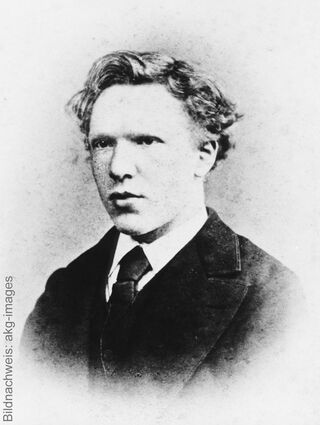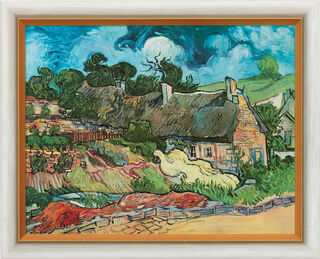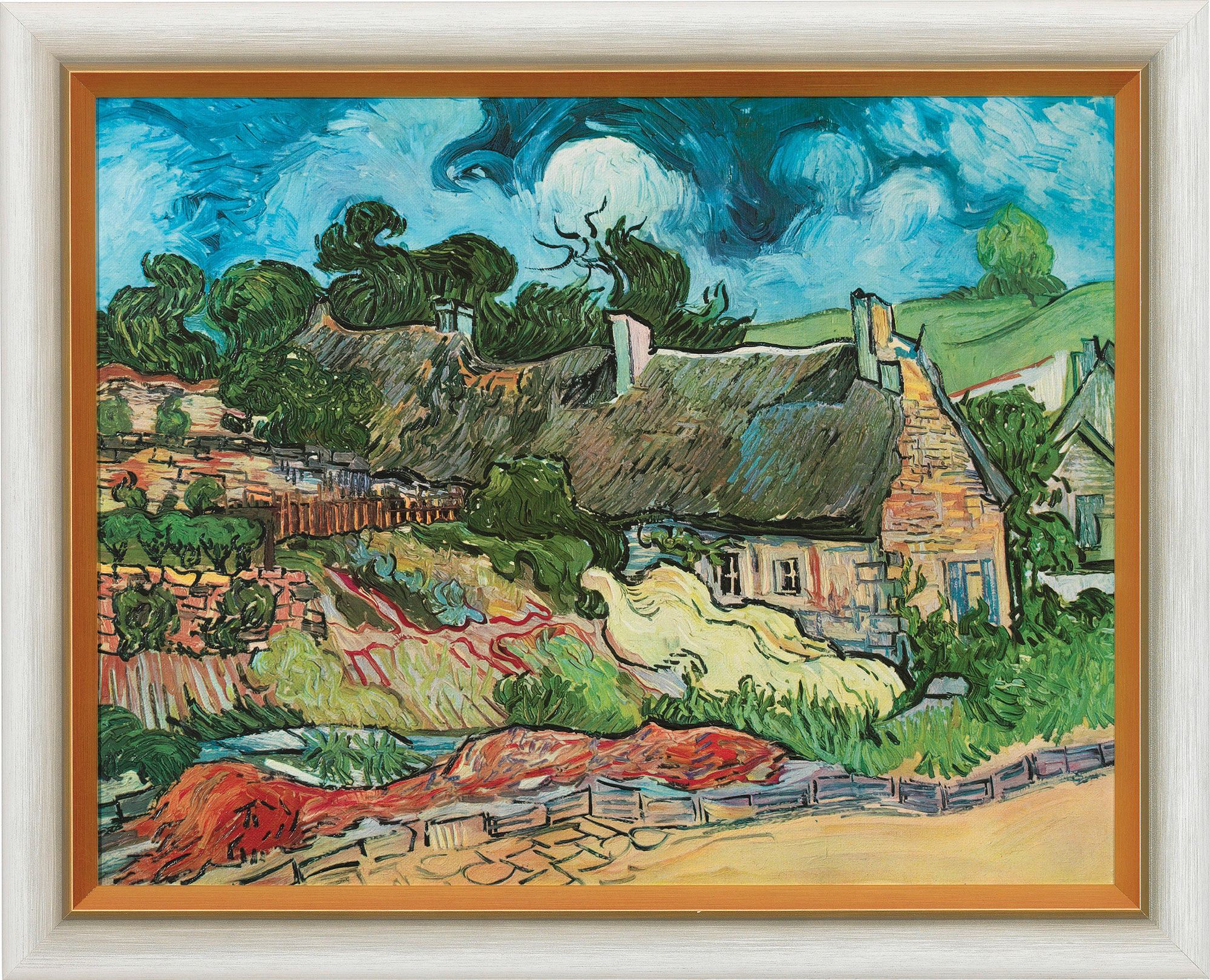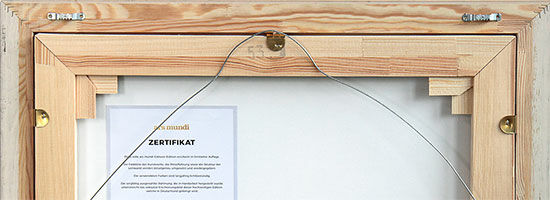Picture "Thatched Cottages at Cordeville" (1890), framed


Picture "Thatched Cottages at Cordeville" (1890), framed
Quick info
ars mundi Exclusive Edition | limited, 499 copies | certificate | reproduction, Giclée print on canvas | on stretcher frame | framed | size 48 x 59 cm (h/w)
Detailed description
Picture "Thatched Cottages at Cordeville" (1890), framed
It is impossible to tell from the paintings of Vincent van Gogh (1853-1890) that the Dutch painter, who is now highly remunerated, literally struggled with every brushstroke. Sometimes it was because of the cost of paint, canvas or studio, and other times it was because of the inspiration that often came over him in bursts. These intense moments of creativity gave rise to legendary works that anticipated the Fauves and Expressionism. During his 70 days stay in Auvers-sur-Oise alone, he created around eighty paintings.
This painting was also created during his last and most turbulent creative phase. Artists like Pissarro or Cézanne had praised the peaceful charm of Auvers. But van Gogh transformed the landscape into a volcanic area where houses look as if they had been shaken by an earthquake.
Original: Oil on canvas. Musée d'Orsay, Paris.
High-quality reproduction using the Fine Art Giclée process technique, worked by hand on artist's canvas (cotton canvas), with tactile and visible brush structure. Mounted on a stretcher frame. Limited edition 499 copies, with certificate. In handmade real wood gallery frame in white with gold edge, grey patinated. Size 48 x 59 cm (h/w). ars mundi Exclusive Edition.
Customer reviews
Wie erwartet: einfach schön und gut wiedergegeben.

About Vincent van Gogh
1853-1890 - Pioneer of Expressionism
"This man will either go mad or he'll leave all the rest of us far behind," predicted Camille Pissarro about Vincent van Gogh, who was born in 1853 as the son of a priest. And indeed, the Dutchman became a precursor of modernism, ushering in Expressionism with his curved lines and bright colours. While during his lifetime van Gogh could hardly earn enough money from his paintings to buy paint and canvases and had to depend on financial support from his brother Theo, today his works regularly reach multi-million dollar prices at spectacular auctions.
Van Gogh (1853-1890) came from a Protestant pastor's family in Groot-Zundert in Brabant. He first came into contact with art through an uncle who was an art dealer. Initially van Gogh worked in branches of Goupil & Cie Gallery in The Hague, London and Paris, but also as a tutor in England and as a Methodist preacher. He first began to draw as a preacher coal-mining district of Borinage. Afterwards, he attended the Brussels Academy for a few months but mainly continued his education as an autodidact.
His first oil paintings depict poor peasants and workers. These pictures are very dark and painted with simple, broad lines. Via Antwerp, where he stayed for three months and became acquainted with the lightness and elegance of Japanese woodblock prints, he came to Paris. Here he discovered the sun and bright colours. He studied the Impressionists, Pointillists and early Symbolists and painted cityscapes, landscapes and portraits.
Seeking more light and freedom, he went to Arles in the south of France in 1888, where his friend Paul Gauguin followed him. Van Gogh planned to establish an artist commune there and invite all his painter friends to live and work with him, but the plan failed. After a dramatic confrontation with Gauguin, in which van Gogh injured his ear, he had to spend several long periods in hospitals due to mental breakdowns. These crises later intensified and eventually led to his suicide.
Van Gogh's most famous paintings were created during his time in Arles. All the luminosity of the sun can be seen in these paintings; fields, trees and clouds reflect the power of nature in an impressive way. For us viewers today, it is hard to imagine the strength that may have been needed to produce such joyful masterpieces in the midst of personal psychological misery. It remains van Gogh's secret - and it remains the secret of his late work to this day.
Graphic or sculpture edition that was initiated by ars mundi and is available only at ars mundi or at distribution partners licensed by ars mundi.
Giclée = derived from the French verb gicler "to squirt, spurt".
The giclée method is a digital printing process. It is a high-resolution, large-format printout on an inkjet printer with special different-coloured dye- or pigment-based inks (usually six to twelve). The colours are fade-proof, i.e. resistant to harmful UV light. They have a high richness of nuance, contrast and saturation.
The giclée process is suitable for art canvases, handmade and watercolour paper as well as for silk.
The style of Impressionism, which emerged in French painting around 1870, owes its name to Claude Monet's landscape 'Impression, Soleil Levant'. After initial rejection, it began a veritable triumphal procession.
Painters such as Claude Monet, Edgar Degas, Edouard Manet, Auguste Renoir and others created motifs from everyday life, urban and landscape scenes in bright, natural light.
Impressionism can be seen as a reaction to academic painting. The emphasis was not on content with its strict rules of painting structure, but on the object as it appears at any given moment, in an often random cut out. The reality was seen in all its variety of colours in natural lighting. The Studio painting was replaced by open-air painting.
Through the brightening of the palette and the dissolution of firm contours, a new approach to colour emerged. In many cases, the colours were no longer mixed on the palette but side by side on the canvas so that the final impression lies in the eye of the viewer with a certain distance. In "Pointillism", (with painters such as Georges Seurat or Paul Signac) this principle was taken to the extreme.
Outside France, Impressionism was taken up by painters such as Max Slevogt, Max Liebermann and Lovis Corinth in Germany, and by James A. M. Whistler in the United States.
However, Impressionism was only expressed to a limited extent in the art of sculpture. In the works of Auguste Rodin, who is considered one of the main representatives, a dissolution of surfaces is evident, in which the play of light and shadow is included in the artistic expression. Degas and Renoir created sculptures as well.






